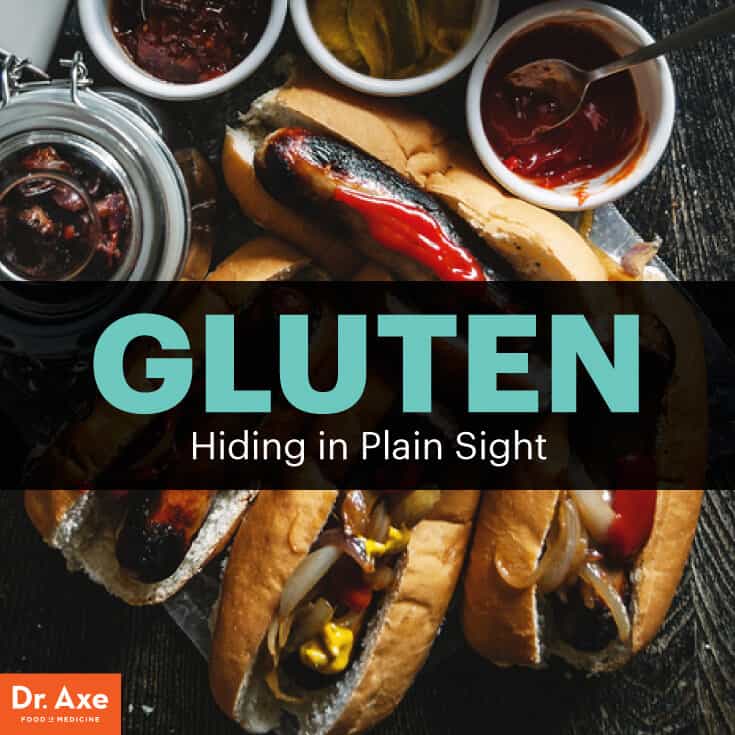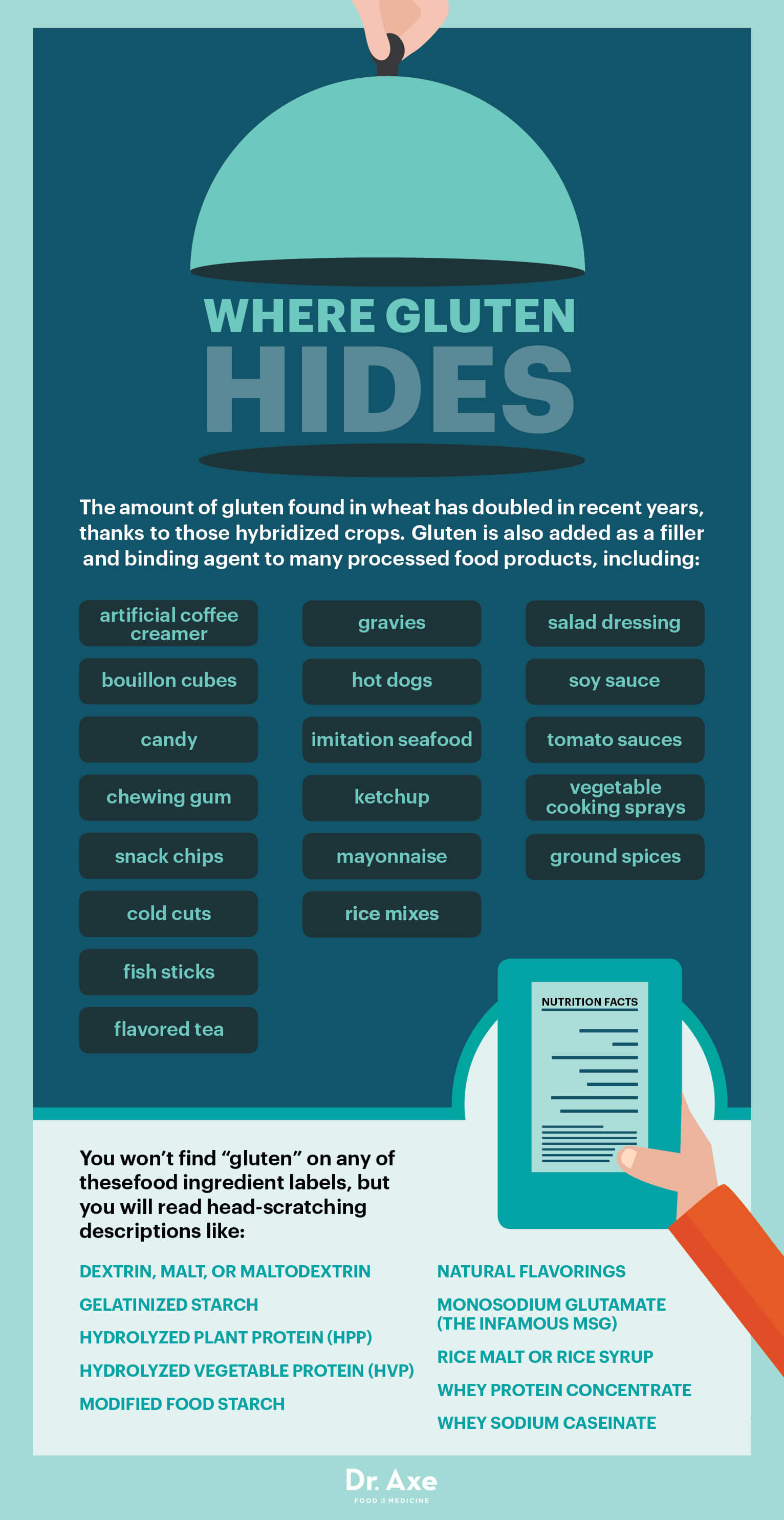Foods with Gluten Hiding in Plain Sight (Be Wary of the “Gluten-Free” Label)

In a Gallup survey conducted this past summer, 20 percent of Americans say they try to include gluten-free foods in their diets. One in five!
Some of these folks know they have celiac disease, which affects about 1 percent of the population worldwide and who are severely allergic to gluten or a sticky protein that occurs naturally in wheat, barley and rye. Others suffer from more common gluten intolerance symptoms or “non-celiac gluten sensitivity,” which is roughly around 6 percent to 7 percent of the population.
Meanwhile, many of us — including those who follow a Paleo diet — are simply hoping to avoid foods that contain gluten because of the unwanted starchy carbohydrates as well as genetically modified and processed grains that can cause inflammatory diseases, weight gain and more.
As a result, food manufacturers are trying to cash in on the gluten-free craze. A Mintel Research study found that sales of gluten-free foods increased by 63 percent between 2012 and 2014, when sales were predicted to reach $8.8 billion. So while some companies may be transitioning to healthier or less allergenic varieties of their products, can you trust these companies to handle such a move properly?
The Cheerios Fiasco
One such company is General Mills, which is making five types of its cereal brand Cheerios gluten-free. While I consider a bowl of Cheerios the definition of “empty carbs,” many people following the gluten-free way were happy to have a supposedly safe version of their favorite childhood cereal. Not so fast.
“We are embarrassed and sorry to share an incident that occurred at our production facility in Lodi, California, that allowed wheat flour to enter our gluten-free oat-based system. As a result, original and Honey Nut Cheerios produced on several dates may contain wheat and were wrongly labeled gluten-free.” This Oct. 5, 2015 press release from General Mills admitted the company’s gigantic gaffe, and it’s been all over the news, for the company has had to recall almost 2 million boxes labeled “gluten-free.”
The FDA has reportedly received complaints from 39 consumerswho claim they’ve gotten sick after consuming the new gluten-free Cheerios.. The company asks customers to check the “better if used by” code dates on Honey Nut Cheerios boxes for July 12–25, 2016, with plant code “LD” at the end. For example, “12JUL2016 LD” to “25Jul2016 LD.” For the yellow boxes of original Cheerios, the dates are July 14–17, 2016: 14JUL2016 LD, 15JUL2016 LD, 16JUL2016 LD and 17JUL2016 LD.
General Mill continues, “We want to reassure you that this was an isolated incident and we have implemented a solution to ensure that this will not happen again.” Are you reassured? Probably not.
Gluten-Containing Foods vs. Non-Gluten Foods
Besides big food companies making the occasional mistake (that can be life-threatening for some), this is coupled with the fact that manufacturing can lead to cross-contamination, in which trace amounts of gluten often wind up in food products that are seemingly gluten-free — like salad dressings, condiments, deli meats and candy. This makes giving up gluten more challenging than it might initially seem.
I’ve found this creates either the paranoid consumer or the blasé one. Some avoid too many foods, such as thinking that rice and potatoes contain gluten and asking if oats are gluten-free. They are. Others are unaware that they’re consuming foods that contain gluten, including many processed foods, beer and even dietary supplements.
So while food manufacturers can get into some hot water with the FDA for making mistakes like General Mills did, the FDA inspects only a tiny fraction of the foods in stores and often relies on consumers to report problems.
For a quick refresh, here’s a list of popular foods that contain gluten (and which may surprise you) and then a suitable non-gluten replacement:
Granola: While most granola is supposed to be oat-based, many varieties have wheat gluten mixed in. So be careful and read that label. Or make up a bowl of oatmeal with steel-cut oats. Try my Pumpkin Pie Oatmeal.
Spelt Bread: Because it’s an ancient grain and is so healthy (helping our bones and circulation), spelt flour must be gluten-free, right? Wrong! Instead, there’s some other ancient grains that make great gluten-free flours, including almond flour, coconut flour and even teff.
Ezekiel Bread: This bread made from ancient grains suffers the same fate as spelt, as it contains gluten. However, because it’s sprouted, it’s easier to digest than most breads and contains more nutrition, so I recommend it for the non-gluten sensitive if you really must have your bread fix with some almond butter. For those suffering from gluten intolerance or celiac disease, go with some healthy sandwich substitutes like collard wraps.
Protein Bars: What?! Yes, most protein bars contain gluten to help with the consistency. Instead, make your own, such as this delicious Almond Butter Banana Protein Bar.
Couscous: Another innocent-looking ancient grain that is actually made from course grain, couscous is a no-no for gluten avoiders. Instead, go with brown rice or even black rice, which is called forbidden rice and will wow you with its health benefits.
French Fries: Okay, I’m killing you now, right? Yes, I’m afraid to tell you that most French fries are dusted with flour before they’re frozen. Instead, make your own or even these tasty Turnip Fries.
Ketchup and Mayonnaise: Many condiments, including ketchup and mayonnaise, may use gluten products as a stabilizer, flavoring or thickener. Instead, go with this crazy healthy but delicious Coconut Oil Mayonnaise or homemade Ketchup.
Gravy: Wheat flour is the time-test thickener that your grandmother still uses, but fortunately there are other options now, such as this Gravy Recipe that uses gluten-free flour.
Meatballs: Along with the thickener reasoning, gluten is often used to keep meatballs together. So get out your apron and make these Gluten-Free Baked Meatballs.
Sausages and Hot Dogs: While some companies stopped the madness (!), some sausage casings and fillings still contain flour. Go with brands like Applegate Farms that are marked gluten-free, or get your sausages and hot dogs at the local farmers’ market and ask about these casings.
Beer & Vodka: You knew about beer (hello barley!) but vodka? Traditionally, vodka is made from gluten-containing grains, but there’s a growing group of specialty vodkas made from alternative materials such as corn, potatoes and grapes. Same story with beer, where gluten-free is a label that beer drinkers are seeking out. Yes, gluten-free alcohol is becoming a thing.
Roasted Nuts: Okay, I take away your beer and now the bowl of nuts, too? If you’re trying to avoid gluten, then you also need to say no to roasted nuts, as they’re almost always made on shared equipment with gluten-containing products. Instead, bring your own raw nuts along for the ride, or roast them yourselves, such as these Salty Lime Roasted Nuts.
Ice Cream: Have to go out with a bang with this list. “Ice cream?!” you scream. While it doesn’t make a lot of sense, many ice creams call for flour to help thicken the mixture. So check that label very carefully or make your own, such as this kefir-based Strawberry Ice Cream or dairy-free Raw Vanilla Ice Cream.
Best step to take? Stop eating these nutritionally bankrupt, packaged convenience foods that contain gluten from big companies! Keep seeking out real food from real people (your local farmers) as much as you can, and then cook it up yourself. Your family’s better health will be the happy result.
How Gluten Contributes to Leaky Gut
The following is an adapted excerpt from my new book “Eat Dirt: Why Leaky Gut May Be the Root Cause of Your Health Problems and 5 Surprising Steps to Cure It“ (Harper Wave)
The unrelenting surplus of excess sugars; unsprouted, hybridized grains; and other nutritionally bankrupt, processed foods in the standard American diet has simply devastated the gut. Of particular concern is gluten, which evidence increasingly points to as a prime driver of leaky gut syndrome. When foods with gluten are consumed, the body undergoes an inflammatory response and eventually releases the protein — zonulin — that unlocks the epithelial tight junctions and keeps the gates of the gut wide open as long as it circulates in the blood. (1)
The biggest problem is that foods with gluten hide right in plain sight, often going overlooked and even something being promoted as healthy food options. In reality, foods that contain gluten damage the gut and can cause even further problems, particularly for people with gluten sensitivity. So what’s the deal with gluten, what are these foods with gluten we should avoid and what role does zonulin play in gluten’s negative side effects? Let’s find out.
Foods with Gluten Hiding Inside
The amount of gluten found in wheat has doubled in recent years, thanks to those hybridized crops. Gluten is also added as a filler and binding agent to many processed foods, including:
- artificial coffee creamer
- bouillon cubes
- candy
- chewing gum
- snack chips
- cold cuts
- fish sticks
- flavored teas
- gravies
- hot dogs
- imitation seafood
- condiments like ketchup and mayonnaise
- rice mixes
- salad dressing
- soy sauce
- tomato sauces
- vegetable cooking sprays
- ground spices
In addition, you won’t find “gluten” on any of these food ingredient labels, but you will read head-scratching descriptions like:
- dextrin, malt or maltodextrin
- gelatinized starch
- hydrolyzed plant protein (HPP)
- hydrolyzed vegetable protein (HVP)
- modified food starch
- monosodium glutamate (the infamous MSG)
- natural flavorings
- rice malt or rice syrup
- whey protein concentrate
- whey sodium caseinate
I believe gluten is a key reason for our nation’s autoimmune crisis, with clear, documented links to diseases like celiac disease, type 1 diabetes and Crohn’s disease. Gluten has also been associated with more than 55 other diseases and is a major trigger for several thyroid conditions, including Hashimoto’s disease.
A study at the University of Turin in Italy demonstrated a strong link between celiac disease, caused by gluten, and the health of the thyroid. (2) Even if you don’t notice any obvious problems, consuming gluten puts your gut at risk for damage. So why eat it at all? I suggest steering clear of just about all foods with gluten.



Speak Your Mind